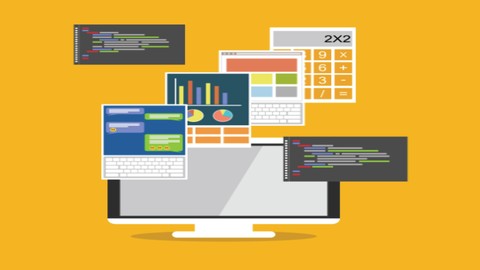
Regression, Data Mining, Text Mining, Forecasting using R
Regression, Data Mining, Text Mining, Forecasting using R, available at $54.99, has an average rating of 4.9, with 192 lectures, 14 quizzes, based on 532 reviews, and has 4672 subscribers.
You will learn about Learn about the basic statistics, including measures of central tendency, dispersion, skewness, kurtosis, graphical representation, probability, probability distribution, etc. Learn about scatter diagram, correlation coefficient, confidence interval, Z distribution & t distribution, which are all required for Linear Regression understanding Learn about the usage of R for building Linear Regression Learn about the K-Means clustering algorithm & how to use R to accomplish this Learn about the science behind text mining, word cloud & sentiment analysis & accomplish the same using R This course is ideal for individuals who are All the IT professionals, whose experience ranges from '0' onwards are eligible to take this session. Especially professionals from data analysis, data warehouse, data mining, business intelligence, reporting, data science, etc, will naturally fit in well to take this course. It is particularly useful for All the IT professionals, whose experience ranges from '0' onwards are eligible to take this session. Especially professionals from data analysis, data warehouse, data mining, business intelligence, reporting, data science, etc, will naturally fit in well to take this course.
Enroll now: Regression, Data Mining, Text Mining, Forecasting using R
Summary
Title: Regression, Data Mining, Text Mining, Forecasting using R
Price: $54.99
Average Rating: 4.9
Number of Lectures: 192
Number of Quizzes: 14
Number of Published Lectures: 181
Number of Published Quizzes: 13
Number of Curriculum Items: 206
Number of Published Curriculum Objects: 194
Original Price: $89.99
Quality Status: approved
Status: Live
What You Will Learn
- Learn about the basic statistics, including measures of central tendency, dispersion, skewness, kurtosis, graphical representation, probability, probability distribution, etc.
- Learn about scatter diagram, correlation coefficient, confidence interval, Z distribution & t distribution, which are all required for Linear Regression understanding
- Learn about the usage of R for building Linear Regression
- Learn about the K-Means clustering algorithm & how to use R to accomplish this
- Learn about the science behind text mining, word cloud & sentiment analysis & accomplish the same using R
Who Should Attend
- All the IT professionals, whose experience ranges from '0' onwards are eligible to take this session. Especially professionals from data analysis, data warehouse, data mining, business intelligence, reporting, data science, etc, will naturally fit in well to take this course.
Target Audiences
- All the IT professionals, whose experience ranges from '0' onwards are eligible to take this session. Especially professionals from data analysis, data warehouse, data mining, business intelligence, reporting, data science, etc, will naturally fit in well to take this course.
Data Science using R is designed to cover majority of the capabilities of R from Analytics & Data Science perspective, which includes the following:
- Learn about the basic statistics, including measures of central tendency, dispersion, skewness, kurtosis, graphical representation, probability, probability distribution, etc.
- Learn about scatter diagram, correlation coefficient, confidence interval, Z distribution & t distribution, which are all required for Linear Regression understanding
- Learn about the usage of R for building Regression models
- Learn about the K-Means clustering algorithm & how to use R to accomplish the same
- Learn about the science behind text mining, word cloud, sentiment analysis & accomplish the same using R
- Learn about Forecasting models including AR, MA, ES, ARMA, ARIMA, etc., and how to accomplish the same using R
- Learn about Logistic Regression & how to accomplish the same using R
Course Curriculum
Chapter 1: Introduction To Data Science
Lecture 1: Introduction
Lecture 2: Data Generation And Information Age
Lecture 3: Big Data And Getting Drenched In Data
Lecture 4: Why Data Science…..?
Chapter 2: Basic Statistics
Lecture 1: Data Types And Preliminaries
Lecture 2: Random Variable
Lecture 3: What Is Probability…?
Lecture 4: Probability Distribution
Lecture 5: Recap Of Concepts And Probability Applications
Lecture 6: Sampling Funnel
Lecture 7: Measures Of Central Tendency
Lecture 8: Measures Of Dispersion
Lecture 9: Measures Of Dispersion Part-2
Lecture 10: Excpected Value And Variance For Discrete Data
Lecture 11: Preliminaries Of R and RStudio
Lecture 12: Various Components And Basics Of RStudio
Lecture 13: Data Visualization Using R-Barplot,Histogram,Skewness
Lecture 14: 3rd And 4th Moment Business Decision
Lecture 15: Recap And Box Plot
Lecture 16: Normal Distribution-Part 1
Lecture 17: Normal Distribution-Part 2 & Standarad Normal Distribution
Lecture 18: Standard Normal Distribution -Part 2
Lecture 19: Calculating Probabilities From Z-Distribution
Lecture 20: Sampling Variation, Sample size & Central Limit Theorem
Lecture 21: Normal Quantile Plot (Q-QPlot)
Lecture 22: Recap Confidence Interval
Lecture 23: Confidence Interval Z-Distribution Part-1
Lecture 24: Confidence Interval Z-Distribution Part-2
Lecture 25: Confidence Interval Interpretation
Lecture 26: Confidence Interval T-Distribution
Lecture 27: Recap Basic Statistics
Lecture 28: Confidence Interval In Data Science
Lecture 29: EXPLORATORY DATA ANALYSIS IN DATA SCIENCE
Chapter 3: Hypothesis Testing Introduction
Lecture 1: Hypothesis Testing Introduction
Lecture 2: Hypothesis Testing Formulation
Chapter 4: Hypothesis Testing- Parametric
Lecture 1: 2 Sample T-Test Part-1
Lecture 2: 2 Sample T-Test Part-2
Lecture 3: 2 Sample T-Test Part-3
Lecture 4: 1 Sample Z Test Part-1
Lecture 5: 1 Sample Z Test Part-2
Lecture 6: 1 Sample T Test
Lecture 7: One Way ANOVA Part-1
Lecture 8: One Way ANOVA Part-2
Lecture 9: One Way ANOVA Part-3
Lecture 10: ANOVA-Intuition Part 1
Lecture 11: ANOVA-Intuition Part 2
Lecture 12: ANOVA-1,2 Multiple Way
Lecture 13: Tukey Pairwise Comparisons Part-1
Lecture 14: Tukey Pairwise Comparisons Part-2
Lecture 15: 2 Proportion Test
Lecture 16: Chi Square Test
Chapter 5: Hypothesis Testing-Non Parametric
Lecture 1: 1 Sample Sign Test
Lecture 2: Mann Whitney Test
Lecture 3: Paired T Test Assumption
Lecture 4: Paired T Test
Lecture 5: Moods Median Test
Chapter 6: BASICS OF R-PROGRAMMING
Lecture 1: Basic Programing Using R Part 1
Lecture 2: Basic Programing Using R Part 2
Lecture 3: Basic Programing Using R Part 3
Lecture 4: Basic Programing Using R Part 4
Lecture 5: R Programming Case Study Part 1
Lecture 6: R Programming Case Study Part 2
Lecture 7: R Programming Case Study Part 3
Lecture 8: R Programming Case Study Part 4
Lecture 9: Stastical Packages In R
Lecture 10: R Programming Case Study Using Inbuilt Datasets
Lecture 11: Case Study On Data Visualization Using R Part 1
Lecture 12: Case Study On Data Visualization Using R Part 2
Lecture 13: Case Studay On Data Visualization Using R Part 3
Lecture 14: Case Study On Data Visualization Using R Part 4
Lecture 15: Recap Exploratory Data Analysis
Lecture 16: Must Know Packages For a Successful Data Scientist
Chapter 7: Predictive Analytics
Lecture 1: Scatter Diagram
Lecture 2: Correlation Coefficient
Lecture 3: Simple Linear Regression Introduction
Lecture 4: Simple Linear Regression Using R -Part 1
Lecture 5: Simple Linear Regression Using R – Part 2
Lecture 6: Simple Linear Regression Using R – Part 3
Lecture 7: Simple Linear Regression Using R – Part 4
Lecture 8: Multiple Linear Regression Introduction
Lecture 9: Multiple Linear Regression Using R – Part 1
Lecture 10: Multiple Linear Regression Using R – Part 2
Lecture 11: Multiple Linear Regression Using R – Part 3
Lecture 12: Recap Linear Regression
Lecture 13: Understanding Logistic Regression Concepts
Lecture 14: Logistic Regression Part 1
Lecture 15: Logistic Regression Part 2
Lecture 16: Logistic Regression Part 3
Lecture 17: Logistic Regression Part 4
Lecture 18: Logistic Regression-Logistic Function Representation
Instructors
-
ExcelR Solutions
Pioneer in professional management trainings & consulting
Rating Distribution
- 1 stars: 20 votes
- 2 stars: 34 votes
- 3 stars: 98 votes
- 4 stars: 152 votes
- 5 stars: 228 votes
Frequently Asked Questions
How long do I have access to the course materials?
You can view and review the lecture materials indefinitely, like an on-demand channel.
Can I take my courses with me wherever I go?
Definitely! If you have an internet connection, courses on Udemy are available on any device at any time. If you don’t have an internet connection, some instructors also let their students download course lectures. That’s up to the instructor though, so make sure you get on their good side!
You may also like
- Best Video Editing Courses to Learn in February 2025
- Best Music Production Courses to Learn in February 2025
- Best Animation Courses to Learn in February 2025
- Best Digital Illustration Courses to Learn in February 2025
- Best Renewable Energy Courses to Learn in February 2025
- Best Sustainable Living Courses to Learn in February 2025
- Best Ethical AI Courses to Learn in February 2025
- Best Cybersecurity Fundamentals Courses to Learn in February 2025
- Best Smart Home Technology Courses to Learn in February 2025
- Best Holistic Health Courses to Learn in February 2025
- Best Nutrition And Diet Planning Courses to Learn in February 2025
- Best Yoga Instruction Courses to Learn in February 2025
- Best Stress Management Courses to Learn in February 2025
- Best Mindfulness Meditation Courses to Learn in February 2025
- Best Life Coaching Courses to Learn in February 2025
- Best Career Development Courses to Learn in February 2025
- Best Relationship Building Courses to Learn in February 2025
- Best Parenting Skills Courses to Learn in February 2025
- Best Home Improvement Courses to Learn in February 2025
- Best Gardening Courses to Learn in February 2025






















